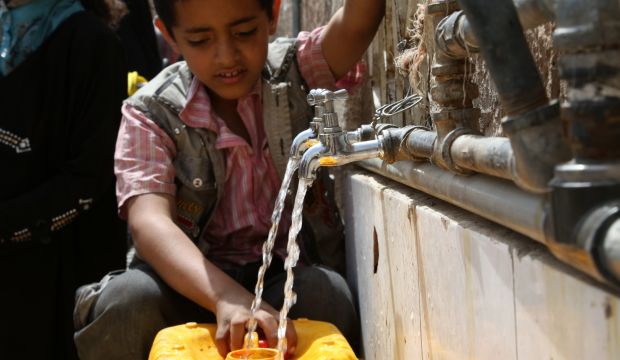
Yemeni people carry drinkable water in Sana’a, Yemen, on June 16, 2014. (Sinan Yiter/Anadolu Agency/Getty Images)
In classical times, Yemen was called Eudaimon Arabia and Arabia Felix (meaning “fortunate”), thanks to the rains which fell on its mountains, almost unique in an otherwise arid Arabian Peninsula. In those days the rains were heavier, so today less groundwater is now available in the aquifers.
Yet as supply has fallen, demand has risen dramatically. According to the World Bank, Yemen’s population was 5.1 million in 1960. Twenty years later it was 7.9 million, and in 2000 it had reached 17.5 million. By 2012, the figure had risen to almost 24 million. According to the UNHCR, there are also perhaps a million refugees from the Horn of Africa, Iraq, Syria and Palestine sheltering there.
All of these people need fresh water to drink and to wash in. There is also a need for water to build or enlarge houses, whether made of concrete or adobe. Then there’s agriculture, which accounts for about 90 percent of the water used in Yemen. Even so, by 2008, “95 percent of consumed cereals and 85 percent of food was imported,” according to the UN’s IRIN news service. Yemen was mostly self-sufficient in food until the 20th century CE, although rice was first imported to counter the famine of 1885. While population growth accounts for some of the difference, much of the production fall-off is due to substitution of food for qat farming, using flood irrigation. Qat used to be rain-fed in the western mountains, and it was not until the 18th century CE that it was grown near Sana’a. Then, in the 1980s, diesel generators enabled flood irrigation.
Another major issue is unregulated water drilling rigs. Although, legally speaking, these have required a license since 2002, in practice little is done to enforce this. As a result of uncoordinated and unplanned drilling, the water table is falling precipitously. In the mountains, groundwater has always been deep (as shown by the inclined ramps for animals to walk down that are common there), but now wells are being drilled to depths of a kilometer, and the remaining water at that depth is brackish and bitter. Another report from IRIN even suggests that the Yemeni capital, Sana’a, may run out of economically viable water supplies by 2017.
So how does Yemen intend to cope with this existential issue? In 2009, it was announced that a major new water source had been discovered in the Hadhramaut region, which would provide its capital, the sea port Mukalla, with potable water “for the next fifty years,” according to IRIN. Similarly, in June 2014, the Yemen Post reported that the country was preparing to begin constructing its first desalination plant. “The project will cost an estimated 300 million US dollars,” the paper reported, “and will help Yemen cope with its growing water demands at a time when its natural aqua-resources have been dangerously depleted by irresponsible qat farming and well digging . . . The plant will provide water for the provinces of Taiz, Lahj, Aden and Ibb. Within the next decade the desalination plant will also be able to supply the capital, Sana’a.”
This is problematic for two reasons. Sana’a lies at 3,000 meters above sea level, and the waters of the Red Sea and the Gulf of Aden are both far more saline than the open ocean, due to evaporation. Thus, not only is the reverse osmosis process used in many desalination plants less efficient in this case, but the cost of lifting water up to Sana’a is also prohibitive.
Rather than fix the problem—poor water resource management—Yemen has been chasing a means to mitigate the solution, seeking a technical fix. As well as all the other problems on its plate, the government of Yemen needs to halt or reverse population growth, implement more efficient irrigation, and control the water drilling-rigs. In First Aid, one stops the bleeding before administering an intravenous drip. Similarly, Yemen must stop its water bleeding away before it tries to find more.
This article was originally published in The Majalla.
All views expressed in this blog post are those of the author and do not necessarily represent the views of, and should not be attributed to, The Majalla magazine or Asharq Al-Awsat newspaper.
